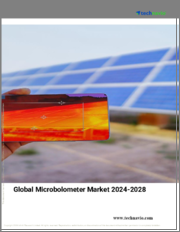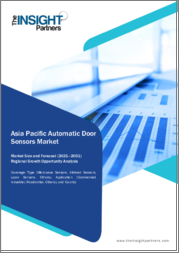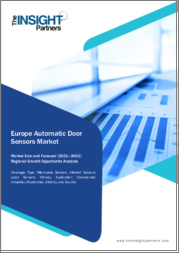
|
시장보고서
상품코드
1495953
적외선 센서 시장 - 예측(2024-2029년)Infrared Sensor Market - Forecasts from 2024 to 2029 |
||||||
적외선 센서 시장은 연평균 11.29%의 CAGR로 2022년 5억 3,300만 달러에서 2029년 11억 2,700만 달러로 성장할 것으로 예상됩니다.
적외선 센서는 시야 내의 물체에서 방출되는 적외선을 감지하고 측정합니다. 적외선 센서는 물체에서 방출되는 적외선 에너지의 온도와 복사 강도의 변화를 감지하고 그 정보를 다른 장치나 시스템에서 해석할 수 있는 전기 신호로 변환합니다.
적외선 센서는 주로 수동형과 능동형 두 가지 종류가 있으며, 물체에서 방출되는 적외선의 변화를 감지하기 때문에 광 파워 미터, 복사 온도계, 모션 센서, 야간 투시 장치, 근접 센서 등 다양한 용도로 사용할 수 있습니다. 자동화 및 제어 시스템에 대한 수요 증가, 비접촉식 온도 측정의 필요성, 야간 투시 장비의 채택 증가 등이 적외선 센서의 수요를 증가시켜 시장 성장을 촉진하고 있습니다.
보안 및 감시 부문에서의 사용 증가가 시장 성장을 촉진
적외선 감지기, 특히 초전 적외선 센서는 보안 및 감시 애플리케이션에 광범위하게 사용되고 있습니다. 전 세계적으로 비디오 감시 시스템의 도입이 증가하고 있으며, 이는 이 분야에서 사업을 운영하는 벤더들에게 큰 기회가 되고 있습니다.
최근 델리 정부가 발표한 CCTV 카메라 프로젝트 2단계로 14만 대의 장치를 배치할 계획을 밝힌 것은 감시 역량 강화에 많은 투자를 하고 있음을 보여줍니다. 또한, 이 프로젝트의 2단계에는 14만 대의 감시 카메라가 추가로 설치될 예정입니다.
이러한 감시 장비의 급증은 보안 대책의 중요성을 강조하며, 보안 인프라 강화에 있어 적외선 감지기가 매우 중요한 역할을 하고 있음을 강조합니다.
자동차 및 전자제품 생산이 급증하면서 적외선 센서에 대한 수요가 증가하고 있습니다.
근접 센서는 물리적 접촉 없이도 주변 물체의 존재를 감지하는 데 사용되는 전자 장치입니다. 적외선 센서는 물체에서 방출되는 적외선을 감지하고 이 정보를 사용하여 물체의 근접성을 판단할 수 있기 때문에 근접 센서로 특히 유용합니다.
근접 센서에 대한 수요는 자동차 산업과 가전 산업에서 증가하고 있습니다. 자동차 산업에서 근접 센서는 주차 보조, 충돌 방지 및 기타 안전 기능에 사용됩니다. 반면, 스마트폰, 태블릿 및 기타 가전제품의 사용자 경험을 향상시키는 터치리스 컨트롤, 제스처 인식 및 기타 기능에 특히 유용합니다. 자동차 및 가전제품의 생산 확대는 적외선 센서에 대한 수요를 증가시킬 것입니다.
국제자동차산업협회(OICA)에 따르면, 세계 승용차 생산량은 2021년 5,705만 대에서 2022년 6,159만 대로 증가했으며, 인도 브랜드 자산 재단(IBEF)에 따르면, 인도에서 출하되는 스마트폰 출하량은 2021년에 1억 6,800만 대를 넘어설 것이며, 2022년에는 1억 9,000만 대에 달할 것으로 예상됩니다. 이는 적외선 센서가 미래에 큰 수요를 가질 것임을 보여줍니다.
야간 투시 장비의 보급이 적외선 센서 시장의 성장을 촉진하고 있습니다.
야간 투시 고글, 쌍안경, 적외선 카메라 등 야간 투시 장비는 적외선 기술을 사용하여 야간에 미약한 빛을 감지하고 증폭하여 어둠 속에서도 시야를 확보할 수 있도록 합니다. 적외선 센서는 완전한 어둠 속에서도 적외선을 감지할 수 있기 때문에 야간 투시 장비에 특히 유용합니다.
야간 투시 장비는 군사, 법 집행, 사냥, 야생동물 관찰, 내비게이션 등의 용도로 사용됩니다. 이러한 응용 분야에서 야간 투시 장비에 대한 수요가 증가하면서 적외선 센서에 대한 수요도 증가하고 있습니다.
2022년 인도의 세계 국방 및 국토안보 솔루션 제공 업체는 국영 힌두스탄 항공(HAL)으로부터 조명, 유틸리티 및 헬리콥터(LUH)용 야간 투시경 고글의 설계 및 개발 계약을 수주했습니다.
아시아태평양은 예측 기간 동안 큰 시장 점유율을 차지할 것으로 예상됩니다.
아시아태평양은 중국, 일본, 한국, 인도 등의 국가에서 빠르게 성장하고 있는 소비자 전자제품 시장, 성장하는 자동차 산업, 암시의 사용 증가로 인해 주요 시장 점유율을 차지할 것으로 예상됩니다.
2022년 2월, 인도 내 자동차 생산을 촉진하고 신규 투자를 유치하기 위해 Tata Motors Ltd, Suzuki Motor Gujarat, Mahindra & Mahindra, Hyundai, Kia India Pvt. 생산연동형 인센티브(PLI)를 받기로 했습니다. 20개 자동차 업체는 총 45,000루피(약 5억 9,500만 달러)의 투자를 제안했으며, 2021년 중국 정부는 '수출 감세 조정'을 발표하여 가전제품을 포함한 특정 제품의 수출 감세율을 조정했습니다.
이번 조정은 고부가가치 제품의 수출을 지원하고 세계 시장에서 중국 기업의 경쟁력을 강화하는 것을 목표로 하고 있습니다. 이러한 신흥국 시장 개척은 자동차 및 가전제품에 사용되는 적외선 센서에 대한 수요를 증가시켜 지역 시장의 성장을 촉진할 것으로 보입니다.
시장 개척:
- 2023년 7월 24일, STMicroelectronics는 빌딩 자동화 시스템에서 존재 감지 및 동작 감지를 위해 설계된 혁신적인 적외선(IR) 센서를 발표했습니다. 이 고집적 센서는 초저전력으로 작동하며 기존의 수동형 적외선 감지기를 대체할 수 있는 마이크로 가공 열 트랜지스터를 탑재하고 있습니다. 기존 PIR 감지기와 달리 STHS34PF80 센서는 정지된 물체를 감지할 수 있는 열 트랜지스터가 내장되어 있기 때문에 센서의 응답을 트리거하기 위해 물체가 움직일 필요가 없습니다. 또한, PIR 센서는 일반적으로 움직이는 물체를 감지하기 위해 프레넬 렌즈가 필요하지만, ST의 새로운 감지기는 렌즈가 필요 없는 간단한 구조로 되어 있습니다.
- 2023년 4월, NEC Corporation은 독자적인 추출 기술을 통해 고순도 반도체 나노튜브를 이용한 세계 최초의 고감도 비냉각 적외선 이미지 센서를 개발했습니다.
- 2023년 1월, 유럽 컨소시엄은 유럽이 고성능 적외선 센서 생산에서 기술 주권을 확보할 수 있도록 1,900만 유로 규모의 적외선 센서 프로젝트를 시작했습니다.
- 2022년 12월, Leonardo DRS는 미 육군에 3세대 FLIR 센서를 공급하는 계약을 체결했습니다. 이 계약에 따라 회사는 FLIR Dewar Cooler Bench(DCB) 장거리 센서의 생산을 저속으로 시작할 예정입니다. 이 새로운 적외선 센서는 수평 기술 통합(HTI)으로 알려진 육군의 현재 2세대 센서를 대체하는 것을 목표로 하며, DCB 센서는 적외선을 비디오 이미지로 변환하여 육군의 FLIR 조준기를 차세대 기능으로 강화하도록 설계되었습니다. 특히 전장의 열악한 환경과 악천후에서 상황 인식을 강화하기 위해 범위와 해상도에 다양한 개선 사항을 도입할 예정입니다.
- 2021년 3월, 미쓰비시전기(Mitsubishi Electric Corporation)는 보안, 난방, 환기, 공조(HVAC), 인원 계수, 스마트 빌딩, 열화상 스캐너 등의 애플리케이션을 위해 넓은 시야각(FoV)과 80x60픽셀의 고해상도를 특징으로 하는 새로운 적외선 센서인 새로운 적외선 센서 'Mitsubishi Electric Diode InfraRed(MelDIR) 센서'를 출시했습니다.
목차
제1장 소개
- 시장 개요
- 시장 정의
- 조사 범위
- 시장 세분화
- 통화
- 가정
- 기준 연도와 예측 연도 타임라인
- 이해관계자에 대한 주요 이점
제2장 조사 방법
- 조사 디자인
- 조사 과정
제3장 주요 요약
- 주요 조사 결과
- 애널리스트의 견해
제4장 시장 역학
- 시장 성장 촉진요인
- 시장 성장 억제요인
- Porter's Five Forces 분석
- 업계 밸류체인 분석
- 애널리스트의 견해
제5장 적외선 센서 시장 : 유형별
- 소개
- 액티브
- 패시브
제6장 적외선 센서 시장 : 용도별
- 소개
- 모션 검출기
- 근접 센서
- 광파워 미터
- 방사 온도계
- 야시 장비
- 기타
제7장 적외선 센서 시장 : 지역별
- 소개
- 북미
- 남미
- 유럽
- 중동 및 아프리카
- 아시아태평양
제8장 경쟁 환경과 분석
- 주요 기업과 전략 분석
- 시장 점유율 분석
- 합병, 인수, 합의와 협업
- 경쟁 대시보드
제9장 기업 개요
- ABB
- Amphenol
- Excelitas Technologies Corp
- Honeywell International Inc.
- Murata Manufacturing Co. Ltd
- Omron Corporation
- Panasonic
- Raytheon Technologies Corporation
- STM Electronics
- TE Connectivity
The infrared sensor market is expected to grow at a CAGR of 11.29% from US$0.533 billion in 2022 to US$1.127 billion in 2029.
Infrared sensors detect and measure infrared radiation emitted by objects in their field of view. They work by detecting changes in the temperature or radiation intensity of the infrared energy emitted by objects and then convert this information into an electrical signal that can be interpreted by other devices or systems.
The two main types of infrared sensors are passive and active, which can be used in various applications, including optical power meters, radiation thermometers, motion detectors, night vision devices, and proximity sensors, as infrared sensors can detect changes in the infrared radiation emitted by objects. The growing demand for automation and control systems, the need for non-contact temperature measurement, and the increasing adoption of night vision devices drive the demand for infrared sensors, propelling their market growth.
Increasing use in security and surveillance propels the growth of the market.
Infrared detectors, particularly pyroelectric infrared sensors, find extensive use in security and surveillance applications. The increasing adoption of video surveillance systems worldwide presents a significant opportunity for market vendors operating in this space.
A recent announcement by the Delhi government revealed plans to deploy 140,000 devices as part of the second phase of their CCTV camera project, indicating a substantial investment in enhancing surveillance capabilities. Furthermore, an additional 140,000 surveillance devices are slated for installation in this project's subsequent phase.
This surge in surveillance device deployment underscores the growing importance of security measures and highlights the pivotal role played by infrared detectors in bolstering security infrastructure.
The surge in automotive and electronic device production is augmenting the demand for infrared sensors.
A proximity sensor is an electronic device that is used to detect the presence of nearby objects without physical contact. Infrared sensors are particularly useful in proximity sensors because they can detect the infrared radiation emitted by objects and use this information to determine their proximity.
The demand for proximity sensors has been increasing in the automotive and consumer electronics sectors. In the automotive industry, proximity sensors are used for parking assistance, collision avoidance, and other safety features. In contrast, they are particularly useful for touchless control, gesture recognition, and other features that improve the user experience in smartphones, tablets, and other consumer electronics devices. The growing production of automotive and consumer electronic devices will boost the demand for infrared sensors.
According to the International Organization of Motor Vehicle Manufacturers (OICA), the global production of passenger vehicles increased to 61.59 million in 2022 from 57.05 million in 2021. According to the India Brand Equity Foundation (IBEF), smartphone shipments from India crossed 168 million units in CY 2021, and in 2022, smartphone shipments from India were expected to reach ~190 million. This demonstrates that infrared sensors hold a great demand in the future.
The growing adoption of night vision devices is boosting the infrared sensor market growth.
Night vision devices like night vision goggles, binoculars, thermal imaging cameras, and others use infrared technology to detect and amplify the faint light available at night, allowing users to see in the dark. Infrared sensors are particularly useful in night vision devices because they can detect infrared radiation even in total darkness.
Night vision devices are used in military and law enforcement applications, hunting, wildlife observation, and navigation. Growing demand for night vision devices in such applications is boosting the demand for infrared sensors.
In 2022, a global defence and homeland security solutions provider of India was awarded the contract to design & develop night vision goggles for Light Utility Helicopters (LUH) by state-owned Hindustan Aeronautics (HAL) where pilots flying (LUH) in different terrains and day/night will get to wear indigenously manufactured Aviation Night Vision Goggles (ANVG).
The Asia Pacific is expected to hold a significant market share throughout the forecast period.
The Asia Pacific region will account for a major market share due rapidly growing consumer electronics market in countries like China, Japan, South Korea, and India, coupled with the growing automotive industry, and increasing usage of night vision devices.
In February 2022, to boost India's domestic vehicle production and draw in new investment, 20 automakers were selected to receive production-linked incentives (PLI), including Tata Motors Ltd, Suzuki Motor Gujarat, Mahindra & Mahindra, Hyundai, and Kia India Pvt. Ltd. The 20 automakers have suggested investment of about Rs. 45,000 crores ($5.95 billion) overall. In 2021, the Chinese government announced "Export Tax Rebate Adjustment" to adjust the export tax rebate rates for certain products, including consumer electronics.
The adjustment aimed to support the export of high-value-added products and boost the competitiveness of Chinese companies in the global market. Such developments will boost the demand for infrared sensors used in automobiles, and consumer electronics, thereby boosting the regional market growth.
Market Developments:
- On July 24, 2023, STMicroelectronics introduced an innovative infrared (IR) sensor designed for presence and motion detection in building automation systems. This highly integrated sensor operates with ultra-low power consumption and features micromachined thermal transistors, replacing traditional passive infrared detectors. Unlike conventional PIR detectors, the STHS34PF80 sensor incorporates thermal transistors capable of detecting stationary objects, eliminating the need for the detected object to be in motion to trigger a response from the sensor. Additionally, while PIR sensors typically require a Fresnel lens for detecting moving objects, ST's new detector offers a simpler construction without the need for a lens.
- April 2023: NEC Corporation, through its proprietary extraction technology, developed the world's first highly sensitive uncooled infrared image sensors, which use high-purity semiconductor nanotubes for infrared detection.
- January 2023: European consortium launched €19M infrared sensor project to enable Europe to gain technological sovereignty in producing high-performance infrared sensors.
- In December 2022, Leonardo DRS secured a contract to supply third-generation FLIR sensors to the US Army. Under this agreement, the company will commence the production of the FLIR Dewar Cooler Bench (DCB) long-range sensor at a low rate. These new infrared sensors are intended to replace the Army's current second-generation sensors known as Horizontal Technology Integration (HTI). The DCB sensor is designed to convert infrared radiation into video images and enhance the Army's FLIR sights with next-generation capabilities. It will introduce various improvements in range and resolution to enhance situational awareness, particularly in challenging battlefield conditions or adverse weather.
- March 2021: Mitsubishi Electric Corporation launched the "Mitsubishi Electric Diode InfraRed (MelDIR) sensor" with a new thermal sensor featuring a wide field of view (FoV) and high 80x60 pixel resolution for applications including security, heating, ventilation, air conditioning (HVAC), people counting, smart buildings and thermal scanners.
Segmentation:
By Type
- Active
- Passive
By Application
- Motion Detectors
- Proximity Sensors
- Optical Power Meters
- Radiation Thermometers
- Night Vision Devices
- Others
By Geography
- North America
- USA
- Canada
- Mexico
- South America
- Brazil
- Argentina
- Others
- Europe
- UK
- Germany
- France
- Spain
- Others
- Middle East and Africa
- Saudi Arabia
- UAE
- Israel
- Others
- Asia Pacific
- China
- Japan
- India
- South Korea
- Others
TABLE OF CONTENTS
1. INTRODUCTION
- 1.1. Market Overview
- 1.2. Market Definition
- 1.3. Scope of the Study
- 1.4. Market Segmentation
- 1.5. Currency
- 1.6. Assumptions
- 1.7. Base, and Forecast Years Timeline
- 1.8. Key Benefits for the stakeholder
2. RESEARCH METHODOLOGY
- 2.1. Research Design
- 2.2. Research Processes
3. EXECUTIVE SUMMARY
- 3.1. Key Findings
- 3.2. Analyst View
4. MARKET DYNAMICS
- 4.1. Market Drivers
- 4.2. Market Restraints
- 4.3. Porter's Five Forces Analysis
- 4.3.1. Bargaining Power of Suppliers
- 4.3.2. Bargaining Power of Buyers
- 4.3.3. Threat of New Entrants
- 4.3.4. Threat of Substitutes
- 4.3.5. Competitive Rivalry in the Industry
- 4.4. Industry Value Chain Analysis
- 4.5. Analyst View
5. INFRARED SENSOR MARKET, BY TYPE
- 5.1. Introduction
- 5.2. Active
- 5.2.1. Market Trends and Opportunities
- 5.2.2. Growth Prospects
- 5.2.3. Geographic Lucrativeness
- 5.3. Passive
- 5.3.1. Market Trends and Opportunities
- 5.3.2. Growth Prospects
- 5.3.3. Geographic Lucrativeness
6. INFRARED SENSOR MARKET, BY APPLICATION
- 6.1. Introduction
- 6.2. Motion Detectors
- 6.2.1. Market Trends and Opportunities
- 6.2.2. Growth Prospects
- 6.2.3. Geographic Lucrativeness
- 6.3. Proximity Sensors
- 6.3.1. Market Trends and Opportunities
- 6.3.2. Growth Prospects
- 6.3.3. Geographic Lucrativeness
- 6.4. Optical Power Meters
- 6.4.1. Market Trends and Opportunities
- 6.4.2. Growth Prospects
- 6.4.3. Geographic Lucrativeness
- 6.5. Radiation Thermometers
- 6.5.1. Market Trends and Opportunities
- 6.5.2. Growth Prospects
- 6.5.3. Geographic Lucrativeness
- 6.6. Night Vision Devices
- 6.6.1. Market Trends and Opportunities
- 6.6.2. Growth Prospects
- 6.6.3. Geographic Lucrativeness
- 6.7. Others
- 6.7.1. Market Trends and Opportunities
- 6.7.2. Growth Prospects
- 6.7.3. Geographic Lucrativeness
7. INFRARED SENSOR MARKET, BY GEOGRAPHY
- 7.1. Introduction
- 7.2. North America
- 7.2.1. By Type
- 7.2.2. By Application
- 7.2.3. By Country
- 7.2.3.1. United States
- 7.2.3.1.1. Market Trends and Opportunities
- 7.2.3.1.2. Growth Prospects
- 7.2.3.2. Canada
- 7.2.3.2.1. Market Trends and Opportunities
- 7.2.3.2.2. Growth Prospects
- 7.2.3.3. Mexico
- 7.2.3.3.1. Market Trends and Opportunities
- 7.2.3.3.2. Growth Prospects
- 7.2.3.1. United States
- 7.3. South America
- 7.3.1. By Type
- 7.3.2. By Application
- 7.3.3. By Country
- 7.3.3.1. Brazil
- 7.3.3.1.1. Market Trends and Opportunities
- 7.3.3.1.2. Growth Prospects
- 7.3.3.2. Argentina
- 7.3.3.2.1. Market Trends and Opportunities
- 7.3.3.2.2. Growth Prospects
- 7.3.3.3. Others
- 7.3.3.3.1. Market Trends and Opportunities
- 7.3.3.3.2. Growth Prospects
- 7.3.3.1. Brazil
- 7.4. Europe
- 7.4.1. By Type
- 7.4.2. By Application
- 7.4.3. By Country
- 7.4.3.1. United Kingdom
- 7.4.3.1.1. Market Trends and Opportunities
- 7.4.3.1.2. Growth Prospects
- 7.4.3.2. Germany
- 7.4.3.2.1. Market Trends and Opportunities
- 7.4.3.2.2. Growth Prospects
- 7.4.3.3. France
- 7.4.3.3.1. Market Trends and Opportunities
- 7.4.3.3.2. Growth Prospects
- 7.4.3.4. Spain
- 7.4.3.4.1. Market Trends and Opportunities
- 7.4.3.4.2. Growth Prospects
- 7.4.3.5. Others
- 7.4.3.5.1. Market Trends and Opportunities
- 7.4.3.5.2. Growth Prospects
- 7.4.3.1. United Kingdom
- 7.5. Middle East and Africa
- 7.5.1. By Type
- 7.5.2. By Application
- 7.5.3. By Country
- 7.5.3.1. Saudi Arabia
- 7.5.3.1.1. Market Trends and Opportunities
- 7.5.3.1.2. Growth Prospects
- 7.5.3.2. UAE
- 7.5.3.2.1. Market Trends and Opportunities
- 7.5.3.2.2. Growth Prospects
- 7.5.3.3. Israel
- 7.5.3.3.1. Market Trends and Opportunities
- 7.5.3.3.2. Growth Prospects
- 7.5.3.4. Others
- 7.5.3.4.1. Market Trends and Opportunities
- 7.5.3.4.2. Growth Prospects
- 7.5.3.1. Saudi Arabia
- 7.6. Asia Pacific
- 7.6.1. By Type
- 7.6.2. By Application
- 7.6.3. By Country
- 7.6.3.1. China
- 7.6.3.1.1. Market Trends and Opportunities
- 7.6.3.1.2. Growth Prospects
- 7.6.3.2. Japan
- 7.6.3.2.1. Market Trends and Opportunities
- 7.6.3.2.2. Growth Prospects
- 7.6.3.3. India
- 7.6.3.3.1. Market Trends and Opportunities
- 7.6.3.3.2. Growth Prospects
- 7.6.3.4. South Korea
- 7.6.3.4.1. Market Trends and Opportunities
- 7.6.3.4.2. Growth Prospects
- 7.6.3.5. Others
- 7.6.3.5.1. Market Trends and Opportunities
- 7.6.3.5.2. Growth Prospects
- 7.6.3.1. China
8. COMPETITIVE ENVIRONMENT AND ANALYSIS
- 8.1. Major Players and Strategy Analysis
- 8.2. Market Share Analysis
- 8.3. Mergers, Acquisitions, Agreements, and Collaborations
- 8.4. Competitive Dashboard
9. COMPANY PROFILES
- 9.1. ABB
- 9.2. Amphenol
- 9.3. Excelitas Technologies Corp
- 9.4. Honeywell International Inc.
- 9.5. Murata Manufacturing Co. Ltd
- 9.6. Omron Corporation
- 9.7. Panasonic
- 9.8. Raytheon Technologies Corporation
- 9.9. STM Electronics
- 9.10. TE Connectivity



















